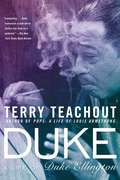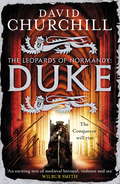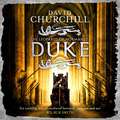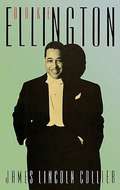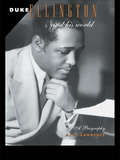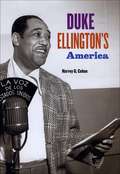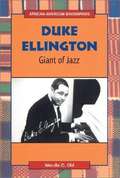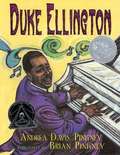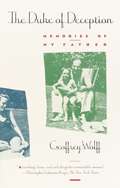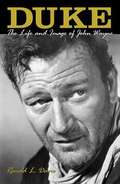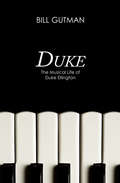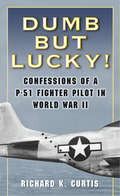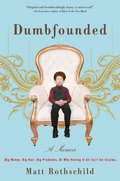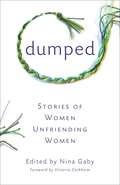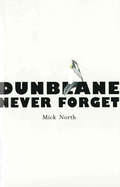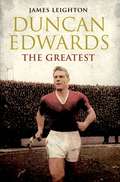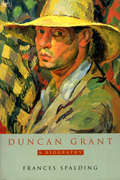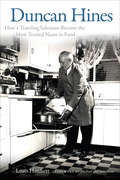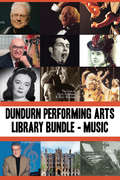- Table View
- List View
Duke
by Terry TeachoutA major new biography of Duke Ellington from the acclaimed author of Pops: A Life of Louis Armstrong Edward Kennedy "Duke” Ellington was the greatest jazz composer of the twentieth century-and an impenetrably enigmatic personality whom no one, not even his closest friends, claimed to understand. The grandson of a slave, he dropped out of high school to become one of the world’s most famous musicians, a showman of incomparable suavity who was as comfortable in Carnegie Hall as in the nightclubs where he honed his style. He wrote some fifteen hundred compositions, many of which, like "Mood Indigo” and "Sophisticated Lady,” remain beloved standards, and he sought inspiration in an endless string of transient lovers, concealing his inner self behind a smiling mask of flowery language and ironic charm. As the biographer of Louis Armstrong, Terry Teachout is uniquely qualified to tell the story of the public and private lives of Duke Ellington. Duke peels away countless layers of Ellington’s evasion and public deception to tell the unvarnished truth about the creative genius who inspired Miles Davis to say, "All the musicians should get together one certain day and get down on their knees and thank Duke. ” .
Duke
by Terry TeachoutA major new biography of Duke Ellington from the acclaimed author of Pops: A Life of Louis Armstrong Edward Kennedy "Duke" Ellington was the greatest jazz composer of the twentieth century--and an impenetrably enigmatic personality whom no one, not even his closest friends, claimed to understand. The grandson of a slave, he dropped out of high school to become one of the world's most famous musicians, a showman of incomparable suavity who was as comfortable in Carnegie Hall as in the nightclubs where he honed his style. He wrote some fifteen hundred compositions, many of which, like "Mood Indigo" and "Sophisticated Lady," remain beloved standards, and he sought inspiration in an endless string of transient lovers, concealing his inner self behind a smiling mask of flowery language and ironic charm. As the biographer of Louis Armstrong, Terry Teachout is uniquely qualified to tell the story of the public and private lives of Duke Ellington. Duke peels away countless layers of Ellington's evasion and public deception to tell the unvarnished truth about the creative genius who inspired Miles Davis to say, "All the musicians should get together one certain day and get down on their knees and thank Duke."
Duke (Leopards of Normandy 2): An action-packed historical epic of battle, death and dynasty
by David Churchill**From the co-author of the No.1 bestselling Wilbur Smith novel, WAR CRY*The Conqueror will rise...The Leopards of Normandy trilogy continues with DUKE, as William of Normandy inherits his father's title and assumes command of his lands. David Churchill's 'exciting mix of medieval betrayal, violence and sex' (Wilbur Smith) is sure to enthral fans of Bernard Cornwell and Conn Iggulden.Normandy, 1037. Sparks fly from clashing swords as the game of thrones plays out in bloodshed. Of those named guardian to the boy Duke, all seek advantage and power. Most wish the boy dead. Some will go to any lengths to make it happen.Across the sea, the struggle for the English crown has seen Queen Emma's beloved son killed. She has two more sons waiting in the wings but Godwin, Earl of Wessex - kingmaker and arch manipulator - has other plans.As the noble families of Europe murder each other in their lust for power and fortune, the boy stands apart.His name is William. His destiny is to conquer.Don't miss the final instalment of The Leopards of Normandy trilogy, as Duke William prepares to take England by storm in CONQUEROR. What readers are saying about DUKE:'To read a novel linked by actual historic characters and events whilst still maintaining a racy narrative is quite something. A fantastic read''One of the best historical novels I have read. Well written, compelling, action-packed, good characters. This is seriously worth reading!'
Duke (Leopards of Normandy 2): An action-packed historical epic of battle, death and dynasty
by David Churchill**From the co-author of the No.1 bestselling Wilbur Smith novel, WAR CRY*The Conqueror will rise...The Leopards of Normandy trilogy continues with DUKE, as William of Normandy inherits his father's title and assumes command of his lands. David Churchill's 'exciting mix of medieval betrayal, violence and sex' (Wilbur Smith) is sure to enthral fans of Bernard Cornwell and Conn Iggulden.Normandy, 1037. Sparks fly from clashing swords as the game of thrones plays out in bloodshed. Of those named guardian to the boy Duke, all seek advantage and power. Most wish the boy dead. Some will go to any lengths to make it happen.Across the sea, the struggle for the English crown has seen Queen Emma's beloved son killed. She has two more sons waiting in the wings but Godwin, Earl of Wessex - kingmaker and arch manipulator - has other plans.As the noble families of Europe murder each other in their lust for power and fortune, the boy stands apart.His name is William. His destiny is to conquer.Don't miss the final instalment of The Leopards of Normandy trilogy, as Duke William prepares to take England by storm in CONQUEROR. What readers are saying about DUKE:'To read a novel linked by actual historic characters and events whilst still maintaining a racy narrative is quite something. A fantastic read''One of the best historical novels I have read. Well written, compelling, action-packed, good characters. This is seriously worth reading!'
Duke (Leopards of Normandy 2): An action-packed historical epic of battle, death and dynasty
by David Churchill**From the co-author of the No.1 bestselling Wilbur Smith novel, WAR CRY. **The Leopards of Normandy trilogy continues with Duke, as William of Normandy inherits his father's title and assumes command of his lands. This vibrant series by David Churchill will enthrall fans of Bernard Cornwell and Conn Iggulden. 'An exciting mix of medieval betrayal, violence and sex' Wilbur Smith.Normandy, 1037. Sparks fly from clashing swords as the game of thrones plays out in bloodshed. Of those named guardian to the boy Duke, all seek advantage and power. Most wish the boy dead. Some will go to any lengths to make it happen.Across the sea, the struggle for the English crown has seen Queen Emma's beloved son killed. She has two more sons waiting in the wings but Godwin, Earl of Wessex - kingmaker and arch manipulator - has other plans.As the noble families of Europe murder each other in their lust for power and fortune, the boy stands apart. His name is William. His destiny is to conquer.(P)2016 Headline Digital
Duke Ellington
by James Lincoln CollierDuke Ellington is considered to be one of the great genius' of jazz--its major composer and leader of probably the most significant of all jazz bands. Yet, other than his own not-very-revealing autobiography and a collection of reminiscences of his band members, there has never been an in-depth biography of this pre-eminent figure in twentieth century music and entertainment. Here at last is the definitive critical biography of both the man and his music. James Lincoln Collier, author of the highly acclaimed Louis Armstrong: An American Genius, has produced a fascinating work which tells the full story of Edward Kennedy Ellington, from his childhood as the pampered and adored only son of a middle-class Washington black family to his death in 1974, hailed as "America's greatest composer" (according to the New York Times obituary) and mourned at his funeral by more than 10,000 people. Collier describes Ellington's charisma--his sense of being special even from childhood, when he would announce to his cousins "I am the grand, noble, Duke; crowds will be running to me,"...the formation of his band, including some of the greatest names in jazz history, among them, Barney Bigard, Johnny Hodges, Cootie Williams, Lawrence Brown, and Paul Gonzavles...his arrival at the legendary Cotton Club in Harlem in the 1920s...his involvement with his manager Irving Mills, who manipulated and cheated him and even put his name on some of Ellington's songs, but who made him famous...his relationship with his family, including his troubled relationship with his son, his marriage and many affairs (including involvements with some of his own musician's women). But most of all, the book is about the creation of the music, from classic songs like "Sophisticated Lady" to the "sacred concerts" of Ellington's last years. Collier maintains that it is not necessary to see Ellington as a "composer" in the narrow sense of the word but as something just as important: an improvising jazz musician. His instrument was a whole band.This is a controversial book--not all will agree with Collier's assessments--but it will enthrall jazz buffs as well as anyone interested in a fascinating life and times.
Duke Ellington and His World: A Biography
by A. H. LawrenceBased on lengthy interviews with Ellington's bandmates, family, and friends, Duke Ellington and His World offers a fresh look at this legendary composer. The first biography of the composer written by a fellow musician and African-American, the book traces Ellington's life and career in terms of the social, cultural, political, and economic realities of his times. Beginning with his birth in Washington, DC, through his first bands and work at the legendary Cotton Club, to his final great extended compositions, this book gives a thorough introduction to Ellington's music and how it was made. It also illuminates his personal life because, for Ellington, music was his life and his life was a constant inspiration for music.
Duke Ellington's America
by Harvey G. CohenDuke Ellington represented a singular, pathbreaking force in music over a half-century. Harvey G. Cohen paints a vivid picture of Ellington's life and times, taking him from his youth in the black middle class to the heights of worldwide acclaim.
Duke Ellington: A Life in Music (Houghton Mifflin Harcourt Vocabulary Readers #Leveled Reader: Level: 4, Theme: 5.2)
by Erick MontgomeryBriefly tells of the life of Duke Ellington, the musician.
Duke Ellington: Giant of Jazz
by Wendie C. OldExamines the life and career of the talented jazz composer, bandleader, and pianist, from his childhood in Washington, D.C., through his battle against racism, to his influence on the world of jazz.
Duke Ellington: His Life in Jazz with 21 Activities (For Kids series)
by Stephanie Stein CreaseCelebrating one of the most influential figures in jazz, this comprehensive biography incorporates the legendary Duke Ellington's talents into engaging activities for children. Enlisting the musician's gifts as a pianist, composer, and band leader, this interdisciplinary approach shows how to create a ragtime rhythm, make a washtub bass, write song lyrics, dance the Lindy Hop, and even design an album cover. Exploring Ellington's life and career, this activity guide includes information on additional topics such as the Harlem Renaissance, the musical evolution of jazz, and how technology has changed over the years--from piano rolls and record albums to CDs, television, and portable music devices. A time line, glossary, selected bibliography, and extensive resources--including Ellington's greatest recordings, related websites, and recommendations for further study--are also included.
Duke Ellington: Man of Music (Leveled Readers 4.5.2)
by Erick MontgomeryDuke Ellington was a great composer and musician. How did he change music in America?
Duke Ellington: The Piano Prince and His Orchestra
by Andrea Davis PinkneyEdward Kennedy "Duke" Ellington, "King of the Keys," was born on April 29, 1899, in Washington, D.C. "He was a smooth-talkin', slick-steppin', piano-playin' kid," writes master wordsmith Andrea Pinkney in the rhythmic, fluid, swinging prose of this excellent biography for early readers. It was ragtime music that first "set Duke's fingers to wiggling." He got back to work and taught himself to "press on the pearlies." Soon 19-year-old Duke was playing compositions "smoother than a hairdo sleeked with pomade" at parties, pool halls, country clubs, and cabarets. Skipping from D.C. to 1920s Harlem, "the place where jazz music ruled," Duke and his small band called the Washingtonians began performing in New York City clubs, including the Cotton Club, where Duke Ellington and his Orchestra was officially born.
Duke Kahanamoku and the Secret History of Surfing (Fountas & Pinnell Classroom, Guided Reading)
by Michael Sandler Ron RandallNIMAC-sourced textbook. Bringing Surfing to the World. One Hawaiian's love for riding the waves—born from a childhood in the water—helped a little–known ancient pastime grow into a hugely popular sport all around the world.
Duke of Deception
by Geoffrey WolffDuke Wolff was a flawless specimen of the American clubman -- a product of Yale and the OSS, a one-time fighter pilot turned aviation engineer. Duke Wolff was a failure who flunked out of a series of undistinguished schools, was passed up for military service, and supported himself with desperately improvised scams, exploiting employers, wives, and, finally, his own son.In The Duke of Deception, Geoffrey Wolff unravels the enigma of this Gatsbyesque figure, a bad man who somehow was also a very good father, an inveterate liar who falsified everything but love.
Duke: The Life and Image of John Wayne
by Ronald L. DavisMore than two decades after his death, John Wayne is still America's favorite movie star. He has become a cultural icon whose stature seems to grow with the passage of time. In this illuminating biography, Ronald L. Davis focuses on Wayne's human side, portraying a complex personality defined by frailty and insecurity as well as by courage and strength.
Duke: The Musical Life of Duke Ellington
by Bill GutmanEdward Kennedy &“Duke&” Ellington was one of jazz&’s greatest innovators. Join Bill Gutman as he explores the fascinating life of this legend from his birth at the turn of the century to his death at the age of seventy‑five. Interviewing Duke&’s friends, fans, and fellow musicians, Gutman documents the progress of a man who dedicated his life to crafting the ever‑changing sound of jazz. Gutman plunges into the history of jazz from its origin in the honky‑tonk sounds of the Ragtime Era to the forms that are widely enjoyed today. Jazz has evolved through the years to become one of the most popular forms of music, with Duke Ellington as chief composer, artist, and perfomer. Gutman&’s account of Ellington&’s life as it parallels the history of jazz provides a fascinating history for both jazz veterans and those new to the art form.
Dumb but Lucky!
by Richard CurtisSecond lieutenant Dick Curtis arrived in Italy in May 1944-twenty years old and part of a shipment of P-51 Mustang fighter pilots so desperately needed that they were rushed into combat with less than thirty hours of flight time in their new high-performance aircraft. Six of the twelve pilots assigned to the 52nd Fighter Group were shot down in the first two weeks. By his ninth mission, Curtis was the only one still flying. A maverick, he barely escaped court-martial with his high-flying antics. Escorting bombers sent to pound heavily defended oil fields was risky enough, but strafing the enemy supply lines, ports, and airfields was even more dangerous. Curtis may chalk up his success to dumb luck, but these missions took exceptional skill and courage. This hair-raising account captures the air war in all its split-second terror and adrenaline-pumping action. From the Paperback edition.
Dumbfounded: Big Money. Big Hair. Big Problems. Or Why Having It All Isn't for Sissies
by Matt RothschildWhat fresh hell is this? I stopped, dumbfounded. My grandmother was at my bedroom door. "What the hell are you doing?" she asked, surprised but not angry. I looked down at my dress. "Playing school. " My grandmother began stroking her chin. Clearly, there were several ways she could take this conversation. "Matthew, what are you wearing?" I could see that she didn't really want to ask this question but felt she had to. "A dress," I said. . . . "And where did you get this dress?" she asked. . . . "I found it?" My grandmother sighed. "So you've been wandering around the women's department at JC Penney? Do you expect me to believe you couldn't find a better dress than that?" The only Jewish family in a luxury Fifth Avenue building of WASPs, the senior Rothschilds took over the responsibility of raising their grandson, Matt, after his mother left him for Italy and a fourth husband. But rearing Matt was no small task--even for his sharp-tongued grandmother, a cross between Lauren Bacall and Bea Arthur, and a lady who Matt grew to love deeply. Matt secretly wore his grandmother's dresses, shoplifted Barbies from FAO Schwarz, invented an imaginary midget butler who he addressed at dinner parties, and got kicked out of nearly every elite school in Manhattan--once for his impersonation of Judy Garland at a recital. He was eventually sent to a boarding school (his grandmother had to ransom off a van Gogh to get him in). But as funny as his hijinks are now, at the time they masked a Jewfroed, chubby, lovable kid, sexually confused and abandoned by his mother, trying to fit in among the precious genteel world he was forced to live in. Matt Rothschild--the man David Sedaris could have been if he'd grown up in an esteemed family on Manhattan's Upper East Side--tells the story of his childhood with humor, honesty, and unlikely compassion for his eccentric relatives, including his mother, in this bitingly entertaining and unexpectedly tender memoir of family dysfunction. From the Hardcover edition.
Dumped: Stories of Women Unfriending Women
by Nina GabyCandid, relatable stories by established and emerging women writers about being discarded by someone from whom they expected more: a close female friend. There are 161 million women in America today, and our friendships are still as primary and universal as back when Ruth and Naomi, Elizabeth and Susan B., and Thelma and Louise made history. When a romantic relationship breaks up, no problem—there&’s an Adele song for that. Health concerns; problems in school; issues at the workplace? We&’ve got our chums to prop us up. Until we don&’t. When our most sustaining relationships dissolve—those with the women friends in our lives—there&’s never been the fanfare that accompanies the loss of other relationships society deems &“more important.&” Until now. In Dumped: Stories of Women Unfriending Women, twenty-five established and emerging writers—including Jacquelyn Mitchard, Ann Hood, Carrie Kabak, Jessica Handler, Elizabeth Searle, Alexis Paige, and editor Nina Gaby—explore the fragile, sometimes humorous, and often unfathomable nature of lost friendship. These, like your own, are stories that stay with you—maybe for a lifetime.
Dunblane: Never Forget
by Dr Mick NorthMick North's daughter Sophie was one of the children killed in the massacre at Dunblane Primary School. Dunblane: Never Forget is a personal account of Mick's life before and after the massacre and includes a critical assessement of the events that led to the tragedy and those that have followed. He begins by recalling his arrival in Stirling and how he and Barbara moved to Dunblane while awaiting the birth of their only child. A few months later Barbara was diagnosed with cancer and the family had to deal with her terminal illness. After the death of Barbara, father and daughter became an inseparable team until that dreadful day in 1996. North writes about how he and the other families dealt with public sympathy, the anti-handgun campaign, the memorial service, the television programmes, newspaper interviews and the creation of the Dunblane Memorial Garden. He describes how it felt to attend a public inquiry into the murder of his child, criticises the local police force and details the ambivalent attitude of the Dunblane community.
Duncan Edwards: The Greatest
by James LeightonDuncan Edwards' death in the 1958 Munich air disaster rocked the nation. The boy wonder, who many regarded as the greatest footballer in the world, was just 21 years old. The story of Duncan Edwards is an inspiration to all sports fans today. Talisman of Manchester United's all-conquering Busby Babes, Edwards was the undisputed star of a team that also boasted the likes of Bobby Charlton and Britain's most expensive footballer, Tommy Taylor. Excelling in attack, midfield and defence, he inspired his team to successive league titles and on a pioneering adventure in the fledgling European Cup competition. His record for the national team was just as impressive. After becoming England's youngest post-war international, he had played a key role in famous victories over the likes of Brazil and world champions West Germany, earning many plaudits for his crunching tackles, venomous shooting and inch-perfect cross-field passes. His off-field conduct also won him many admirers. In an age slowly emerging from rations and austerity, Edwards stayed true to his working-class roots. Even at the height of his fame, as Britain swayed to the revolutionary new sound of rock 'n' roll, he could still be seen playing football in the street with his fans, cycling to Old Trafford on match days and holidaying in Butlins. Was Edwards really was as good as the legend suggests? With the aid of recollections from his friends, opponents and team-mates and using contemporary newspaper reports to build the evidence, Leighton assesses how Edwards was seen at the time and reveals why he remains, to many, the greatest footballer this country has ever seen. Whenever I heard Muhammad Ali on television say he was the greatest, I had to smile. There was only ever one greatest and that was Duncan Edwards. ' Jimmy Murphy, Manchester United assistant manager 'He was the only player that made me feel inferior. ' Sir Bobby Charlton
Duncan Grant: The Art Of Vanessa Bell And Duncan Grant 1910- 1934
by Frances SpaldingThe life of the painter and designer Duncan Grant spanned great changes in society and art, from Edwardian Britain to the 1970s, from Alma-Tadema to Gilbert and George. This authoritive biography combines an engrossing narrative with an invaluable assessment of Grant's individual achievement and his place within Bloomsbury and in the wider development of British art. 'Spalding's skill is to sketch out the intricate emotional web against the bright bold untouchable figure of the artist. . . Her achievement is to let that sense of a man living with his craft shine through on every page: the result is an exceptionally honest and warm portrait. ' Financial Times
Duncan Hines: How a Traveling Salesman Became the Most Trusted Name in Food
by Louis HatchettThis delightful biography &“offers conclusive proof that Hines was not only a real human being, but an American culinary hero&” (The Weekly Standard). Duncan Hines may be best known for the cake mixes, baked goods, and bread products that bear his name, but many people don&’t know that he was a real person and not just a fictitious figure invented for the brand. America's pioneer restaurant critic, Hines discovered his passion while working as a traveling salesman during the 1920s and 1930s—a time when food standards were poorly enforced and food safety was a constant concern. He traveled across America discovering restaurants and offering his recommendations to readers in his bestselling compilation Adventures in Good Eating—and the success of this work and his subsequent publications led Hines to manufacture the extremely popular food products that we still enjoy today. In this biography, Louis Hatchett explores the story of the man, from his humble beginnings in Bowling Green, Kentucky, to his lucrative licensing deal with Procter & Gamble. Following the successful debut of his restaurant guide, Hines published his first cookbook at age fifty-nine and followed it with The Dessert Book—culinary classics including recipes from establishments he visited on his travels, favorites handed down through his family for generations, and new dishes that contained unusual ingredients for the era. Many of the recipes served as inspiration for mixes that eventually became available under the Duncan Hines brand. This is a comprehensive account of the life and legacy of a savvy businessman and an often-overlooked culinary pioneer whose love of good food led to his name becoming a grocery shelf favorite.
Dundurn Performing Arts Library Bundle — Musicians: Opening Windows / True Tales from the Mad, Mad, Mad World of Opera / Lois Marshall / John Arpin / Elmer Iseler / Jan Rubes / Music Makers / There's Music in These Walls / In Their Own Words / Emma Albani / Opera Viva / MacMillan on Music
by Walter Pitman Carol Burnett James Neufeld Stuart Hamilton Lotfi Mansouri Mark Hernandez Ezra Schabas Carl Morey Holly Higgins Jonas Michelle Labrèche-Larouche Robert PoppleThis special twelve-book bundle is a classical and choral music lover’s delight! Canada’s rich history and culture in the classical music arts is celebrated here, both in the form of in-depth biographies and autobiographies (Lois Marshall, Lotfi Mansouri, Elmer Iseler, Emma Albani and more), but also in honour of musical places (There’s Music in These Walls, a history of the Royal Conservatory of Music; In Their Own Words, a celebration of Canada’s choirs; and Opera Viva, a history of the Canadian Opera Company). Canada plays an important role in the promotion and performance of art music, and you can learn all about it in these fine books. Includes Opening Windows True Tales from the Mad, Mad, Mad World of Opera Lois Marshall John Arpin Elmer Iseler Jan Rubes Music Makers There’s Music in These Walls In Their Own Words Emma Albani Opera Viva MacMillan on Music
